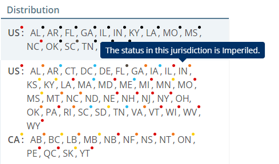A new version of NatureServe Explorer went live on March 12th. You can find it at the usual web address: explorer.natureserve.org. We love it, and we think you will too!
What is the same (but improved!) in the new NatureServe Explorer?
- There is a simplified quick search bar
- Choose Additional Search Options to refine your search by location, status, or classification
- Search results are organized by taxonomic group, and include scientific name, common name, NatureServe Rounded Global Conservation Status, and Subnational distribution
- Click on the hyper-linked scientific name to open the full details page for that species or ecosystem
- Export your search results in Excel or JSON format (previous options were Excel, XML, PDF)
- Species and detail pages contain mostly the same information as before, but reorganized and much easier on the eyes! Notice that the key details are right at the top of the page:
- What is it? (scientific and common names)
- How is it doing? (global conservation status)
- Where is it? (subnational distribution map)
What is different in the new NatureServe Explorer?
- A brand new, sleek design (goodbye pastel yellow!)
- It works equally well on your desktop, tablet or mobile phone – try it!
- Select your preferred interface language of English or French using the dropdown menu (other languages, e.g. Spanish, Portuguese coming in a future release)
- Searches can be done for just species, just ecosystems, or both at once. Hint: toggle the on/off switches to tailor your search

- In addition to names, Global Element Unique Identifiers, ELCODEs, and Ecosystem codes or keys can be used as search terms
- NatureServe Explorer provides a more streamlined way to build and refine your searches. Results are immediately displayed as you make changes.
- A summary of your search criteria is displayed on the top of your screen, and you can easily remove one or all criteria
 Color codes next to each subnation indicate its S-Rank in that jurisdiction. Hint: hover over the color dot to show the S-Rank value
Color codes next to each subnation indicate its S-Rank in that jurisdiction. Hint: hover over the color dot to show the S-Rank value- Search results can be exported and immediately downloaded – no more submitting your email address to retrieve results later
- Ecosystem content is much richer in the new NatureServe Explorer!
- Content is now available at all levels of the International Vegetation Classification (IVC) hierarchy. Hint: you can quickly filter your search results by selecting one of the classification types

- Ecosystems for all of Latin America and the Caribbean are now available (previously only found on Infonatura)
- Climate Change Vulnerability details are now available for some ecological systems in the US
What about APIs?
- API stands for “application programming interface”
- NatureServe Explorer provides a publicly available API through well documented web services that allow other web applications to interact with the underlying NatureServe Explorer data
- This means that NatureServe Network and other partners can make requests to these web services and integrate the responses into their websites or other systems
- An example of this in action is the State Field Guides being developed across the Network, which will use the new NatureServe Explorer APIs in several ways, including accessing a master species list and then periodically refreshing the list by finding all records that have changed since a given date
- Visit explorer.natureserve.org/api-docs/ to access all NatureServe NatureServe Explorer API documentation
What's next for NatureServe Explorer?
NatureServe Explorer is a flagship product of the NatureServe Network, and we want to hear from you how we can make it better! This first release is just the beginning, and we will be adding new features soon., e.g. enhanced map content for species and ecosystems.
Please give the new NatureServe Explorer a test drive, use it early and often. When you find something that doesn’t look right report it. If you think of a feature you would like to see added, tell us about it. Here’s how:
- Visit explorersupport.natureserve.org to access the NatureServe Explorer Help Desk
- Login or register to submit a new ticket (if you are already registered for Biotics or the Environmental Review Tool help desk, the same login works here)
- Alternatively, submit a ticket by emailing explorersupport@natureserve.org